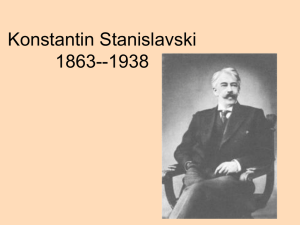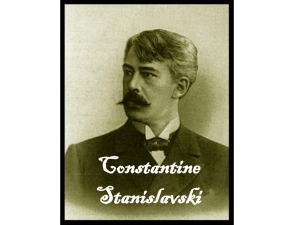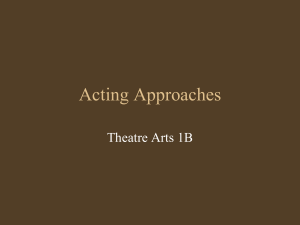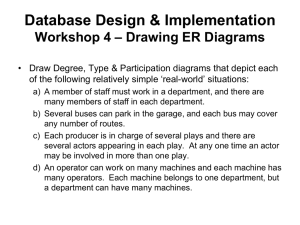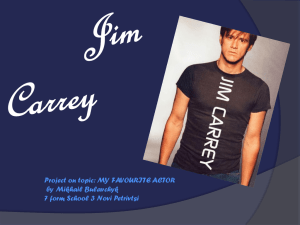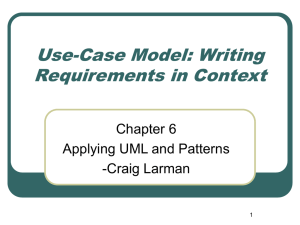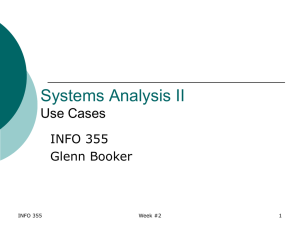Constantine_Stanislavski
advertisement
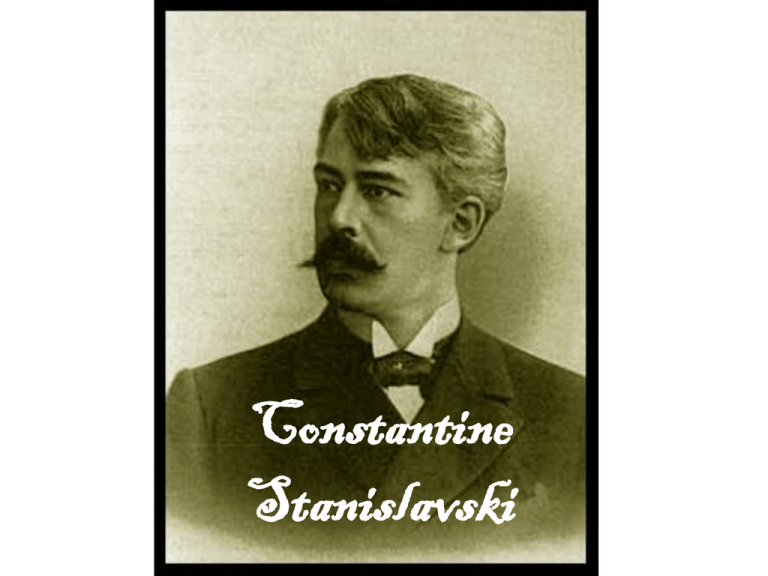
Constantine Stanislavski Constantine Stanislavski • • • • b. Moscow, Russia in 1863. Actor who became a director and teacher. He developed a new approach to acting. As an actor, Stanislavsky saw a lot of bad acting - what he termed as artificial. Stanislavsky wanted actors to work on characters from the inside (instead of the outside) and thus create more of a "true" or "real" (i.e. not artificial) performance. What is it? • The Stanislavsky System is an intense character development process that strives to make a performance "real" and not artificial 1. Bring an actor's experiences into the role. 2. Expand an actor's imagination. • • – (It took years of experimenting to get to what is now known as the Stanislavsky System.) • Stanislavsky believed that in order to make a character true, the character must be approached from the inside. That means drawing on the real inside life of the actor, most specifically drawing on memories. The actor also has to create the inside life of the character: the character has to have inner thought, back story, beliefs, and so on, just as a real person does. When the actor answers questions about the character, they should speak in the first person. "I am..." "I want..." Sense of truth • Learning to tell the difference between the organic and the artificial. Stanislavski believed that there were natural laws of acting, which were to be obeyed. • How does one become a human lie detector? Study oneself and others in all aspects of life: become a student of behavior and emotion and the senses. Given Circumstances • The given circumstances are the character details in the script - the facts the playwright gives the actor. • They are all the pieces of information needed by actors to make the appropriate decisions when interpreting their characters: the story of the play, its “facts,” events, setting (time and place), social/historical context, & conditions of life. • The actor also adopts as part of the given circumstances the elements of the production as they represent the reality: other actors’ interpretations, sets, costumes, properties, lighting and sound effects. Failing that, the actor and production will not be in sync as a believable and whole reality. Analysis of text through action • This helps the actor understand the aim or the main idea of the play. • In analysing an action, the actor answered three questions: • What do I (the character) do? • Why do I (the character) do it? • How do I (the character) do it? Adaptation • Adaptation requires the actor to answer the questions; • What? (action) • Why? (aim) • How? (adaptation) With respect to an action. • The function of adaptation is to allow the actor to transmit ‘invisible messages’ that could not be put in to words. • The problems of action and aim might be addressed during analysis of a play text, but the problem of adaptation would depend on the actor’s interaction with others and the adjustments that would have to be made. • Adaptation could be used to communicate the subtext. Beats & Objectives • Each action is like a bead: strung together, they are the character’s through line of action, which then propels and guides the actor through the entire play. • Furthermore, the actor can break the script down into units, or beats. • A beat is a portion of a scene that contains one objective for an actor. • Every unit has an objective for each character. • An objective is expressed through the use of an active verb. • Not necessarily what happens, but this is what the character is striving for Motivation • Stanislavski insisted that an actor was either driven by emotions or by the mind to choose physical actions. • This in turn aroused the ‘will’ of the actor to perform the given actions. Thus, the ‘will’ became activated indirectly through either emotions or the mind. • The ‘will’ or motivation is in the subconscious. • Motivation become important in realism, it is based on the subtext and any hidden meanings. Super Objective • The Super Objective is the main theme of the play. • The subject of the play. • Everything drives toward the Super Objective. • When all the objectives are strung together in a logical form, a through line of action can be mapped out for the character. Subtext • Subtext refers to the meaning lying underneath the text/ dialogue. • The subtext is not spoken, but is interpreted by the actor through, gesture, posture, pauses or choices in the action. • There is a clear relationship between Subtexts & dialogue and between subtext and objective… “Table Talk” • Stanislavski also innovated by developing the process of “table talk”—the director sitting down with actors and script (usually in advance of any blocking) to study the text, discuss objectives and actions, etc. The Physical Apparatus • Stanislavski believed that an actor’s body and voice is the physical apparatus that is needed in order for the actor to fully express every nuance and subtle shade of character. • He saw the body and voice as ‘instruments’ that could be trained and could help the actor give shape to an actor. • The body needs to be trained, improve posture and make movements supple and graceful, with purpose and truth. Imagination • The more fertile the actor’s imagination, the more interesting would be the choices made in terms of objectives, physical action and creating the given circumstances around the character. • There is no such thing as actually on the stage. Art is a product of the imagination, as the work of a dramatist should be. The aim of the actor should be to use his technique to turn the play into a theatrical reality. In this process the imagination plays by far the greatest part. Magic If… • In realism where the aim of the actor is to create the appearance of reality or ‘truth’ on stage. • Your character is in a specific situation. The Magic If answers the following question: "What would I do if I were in the same situation?“ • The "If" is very important. This about your real life experiences, in combination with your imagination. • The situation is not real, and the system doesn't assume you have ever been in that situation. But knowing yourself, what would you do? How would you act? • Take the imaginary situation and make real life decisions as to how you would behave. • It's crucial to determine the "do" in the question. What action would you take? …Magic If • IF I was to be in this situation what would I do?... Thus, the character's objectives drove the actor’s physical action choices. • Exercise: You are in a play that takes place at a bank. As your character is finishing up with the teller, a bank robber enters and shoots a gun into the air. • If you were in a similar situation… • What would you do? • Would you be a coward or a hero? • Would you yell? • Would you hide behind someone? • Would you run out? • How would this information help in your character development? Communion • Stanislavski called for an unbroken communion between actors. • He differentiated between communication with a real person and an imaginary person. • With a real person, one is aware of the other’s presence and would communicate with them in a natural and realistic way. • An actor would answer the question; ‘What if (--) were really here?’ • The actor should strive to obtain a definite physical result in the partner, for instance, a laugh, a shrug, would stir imagination and create strong communication. Tempo-Rhythm • Tempo-rhythm can act as a powerful bridge between the inner experience and the physical. • ‘Tempo’ refers to the speed of an action of an emotion. Tempo can be slow, medium or fast. • ‘Rhythm’ deals mainly with the internal, the intensity of the emotion. • Stanislavski believed that the tempo-rhythm was extremely vital in order to execute physical actions in a concrete and truthful manner. • He understood the importance of physically and emotionally giving richness to a character through the understanding and creation of tempo-rhythm. Emotional Memory • Emotional memory is taking a personal emotional experience and using it to create emotion on stage. • Recalling situations from your own experience (including events that you’ve read about, heard about, or seen, as well as directly experienced) that are analogous to the character’s situation… • It involves the collaborative work of the imagination and all your senses (taste, touch, sight, smell and hearing) in recalling incidents. Finding an appropriate affective memory is a means of empathizing with the contents of the play so that you can invest them with something from your personal landscape… Emotional Memory • Emotional memory is a way to avoid emotional cliches or “phoniness.” • Many problems with this technique. – Sometimes, the actors couldn’t get out of the emotion, and would go into fits of hysteria. – Other times, they would exhaust the memory and it wouldn’t produce the emotional effect they needed. • Stanislavski began searching for less draining ways to produce emotion. He began emphasizing the actors use of imagination and belief in the given circumstances. • Later on, he developed The Method of Physical Actions. The focus was on the physical actions inspiring truthful emotions and involved improv and discussion. The focus was on reaching the subconscious through the conscious. Sense Memory • Part of recreating reality on stage is reproducing the way a person behaves under the specific circumstances of setting that trigger various of the five senses. Relaxation • Stanislavski thought that relaxation is vital in order to control body and mind. • Only when the actor is relaxed, can the performance be any good. But not totally relaxed. • For example; Ballet. A highly disciplined art form. When ballerinas appear to effortless glide, leap, pirouette, they are not completely relaxed, they hold certain muscles tightly in. If they were totally relaxed, they would lose energy. Concentration • Stanislavski was concerned with actors getting distracted by the audience while performing on stage. He sought ways to counteract this distraction. However did not advocate that the actor forget the audience, or tries to believe it did not exist. That, he felt, would be contradictory to the art of theatre, because the audience was an important ‘co-creator’ of the performance. • He found a way for the actor. He advised that the actor is to fin interest in something (for example, an object) on stage as to not find the presence of the audience a crippling factor. • Stanislavski created the ‘circles of attention’; these circles varied in size and had different purposes. The actor would be in the middle of the circle and the actor would feel secure within their circle and eventually the circle would become bigger over time. Naivete • To enter into a play’s imaginary circumstances, the actor must relearn and develop his childlikepowers to completely believe in invisible stimuli Communication • To go beyond the playwright’s words, an actor must learn to deliver a deeper, living message to the audience…the actor communicates or radiates a subtext of thoughts and feelings to his partners, which then, in turn, affects the audience • Stanislavski invented the pseudo-scientific language of "ray emission" and "ray absorption" to describe the communication process • He believed—at least at one time—that these “waves of the universal life force” could be produced in the hands, fingertips, and eyes of the performer. • What of pauses? – A pause is full of inner action and emotional intensity. It is the silent, inner continuation of one action and the preparation for a new action.
